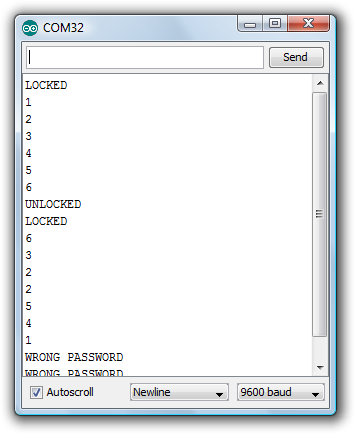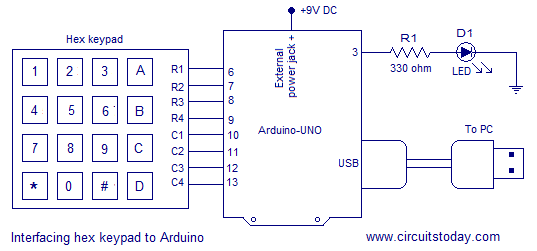Simple digital code lock using arduino.
Digital code lock or digital combination lock are a type of digital locks where a combination of digits/characters or both are used for unlocking the lock. This article is about a simple digital code lock using arduino. Here the code consists of a combination of digits from 1 to 6. There are separate keys for locking and unlocking the system. The system can be unlocked by pressing the unlock button after entering the correct combination of digits. A hex key pad is used as the input device. Only the first two rows of key (1, 2, 3, A, 4, 5, 6, B) are used in this project. A is used for locking the system and B is used for unlocking the system. Read this article Interfacing hex keypad to arduino for knowing more about hex keypad and its interfacing to the arduino. The circuit diagram of the digital code lock using arduino is shown in the figure below.
Note:- We have developed an Advanced Digital Code Lock using Arduino – which is a much improved version of this project. The advanced version comes with an option to Enter User Defined Password at installation. The Lock is interfaced to LCD module to output status. The password input at installation can be changed any time later on a single key press.
Circuit diagram.
Row pins R1 to r4 are interfaced to digital pins 6 to 9 of the arduino. Column pins C1 to C4 are interfaced to digital pins 10 to 13 of the arduino. Digital pin 3 of the arduino is configured as the output pin for delivering the control signal for the solenoid lock. The program and circuit is designed on the assumption that the solenoid lock will “lock” for a low signal at its input and “unlock” for a high signal at its input. In this circuit the solenoid is represented by the LED D1. LED ON means “unlocked” and LED OFF means “locked”. 330 ohm resistor R1 limits the current through the LED.Program.
int p[6]; //array for storing the password
int c[6]; // array for storing the input code
int n;
int a=0;
int i=0;
int lock=3;
int r1=6;
int r2=7;
int r3=8;
int r4=9;
int c1=10;
int c2=11;
int c3=12;
int c4=13;
int colm1;
int colm2;
int colm3;
int colm4;
void setup()
{
pinMode(r1,OUTPUT);
pinMode(r2,OUTPUT);
pinMode(r3,OUTPUT);
pinMode(r4,OUTPUT);
pinMode(c1,INPUT);
pinMode(c2,INPUT);
pinMode(c3,INPUT);
pinMode(c4,INPUT);
pinMode(lock,OUTPUT);
Serial.begin(9600); //sets the baud rate at 9600
digitalWrite(c1,HIGH);
digitalWrite(c2,HIGH);
digitalWrite(c3,HIGH);
digitalWrite(c4,HIGH);
digitalWrite(lock,LOW);
p[0]=1; //sets 1st digit of the password
p[1]=2; // sets 2nd digit of the password
p[2]=3; // sets 3rd digit of the password
p[3]=4; // sets 4th digit of the password
p[4]=5; // sets 5th digit of the password
p[5]=6; // sets 6th digit of the password
}
void loop()
{
digitalWrite(r1,LOW);
digitalWrite(r2,HIGH);
digitalWrite(r3,HIGH);
digitalWrite(r4,HIGH);
colm1=digitalRead(c1);
colm2=digitalRead(c2);
colm3=digitalRead(c3);
colm4=digitalRead(c4);
if(colm1==LOW)
{ n=1;
a=1;
Serial.println("1");
delay(200);}
else
{
if(colm2==LOW)
{ n=2;
a=1;
Serial.println("2");
delay(200);}
else
{
if(colm3==LOW)
{Serial.println("3");
n=3;
a=1;
delay(200);}
else
{
if(colm4==LOW)
{Serial.println("LOCKED");
digitalWrite(lock,LOW); //locks
i=0;
delay(200);}
}}}
digitalWrite(r1,HIGH);
digitalWrite(r2,LOW);
digitalWrite(r3,HIGH);
digitalWrite(r4,HIGH);
colm1=digitalRead(c1);
colm2=digitalRead(c2);
colm3=digitalRead(c3);
colm4=digitalRead(c4);
if(colm1==LOW)
{Serial.println("4");
n=4;
a=1;
delay(200);}
else
{
if(colm2==LOW)
{Serial.println("5");
n=5;
a=1;
delay(200);}
else
{
if(colm3==LOW)
{Serial.println("6");
n=6;
a=1;
delay(200);}
else
{
if(colm4==LOW)
{
if(c[0]==p[0]&&c[1]==p[1]&&c[2]==p[2]&&c[3]==p[3]&&c[4]==p[4]&&c[5]==p[5])
{digitalWrite(lock,HIGH); //unlocks
Serial.println("UNLOCKED");
c[5]=9;} //corrupts the code in array c
else
{Serial.println("WRONG PASSWORD");}
delay(200);}
}}}
if(a==1) // test whether a digit key is pressed
{
c[i]=n; // saves the current digit pressed to array c
i=i+1;
a=0;}
}
About the program.
The password which is “123456” is stored in the array “p”. When ever the digit keys are pressed, they are stored in the array “c”. When ever the unlock button is pressed, the contents in the both array are compared and if they are same then digital pin 3 is made high. After this the content of array “c” corrupted by the program. This is done to prevent the correct code from remaining in the memory. If it is not done the system will unlock just on the press of the unlock button(B) after another lock cycle. Pressing the lock button(A) will make the digital pin low. The lock button has to be pressed before you enter the password each time.
The system can be connected to the PC through the USB and the pressed keys can be viewed through the serial monitor window of the arduino. The screen shot of the serial monitor window of this project is shown in the figure below.
 When lock button (key A in the hex keypad) is pressed the serial monitor window will display “LOCKED”. The code entered will be also displayed on the window. When unlock button (key b in the hex keypad) is pressed the serial monitor window will display “UNLOCKED”. If the code entered is wrong the serial monitor window will display”WRONG PASSWORD”.
When lock button (key A in the hex keypad) is pressed the serial monitor window will display “LOCKED”. The code entered will be also displayed on the window. When unlock button (key b in the hex keypad) is pressed the serial monitor window will display “UNLOCKED”. If the code entered is wrong the serial monitor window will display”WRONG PASSWORD”.
Notes.
- For the present configuration ie; no solenoid, there is no need for the 9V external supply. The board can be powered by the PC through the USB.
- The solenoid will consume a good amount of current and the PC’s USB port may be unable supply it. So when you are using a solenoid a separate external supply for powering it is required. The arduino board can be also powered from this external supply if it is 9V. Check this link Arduino UNO for understanding more about powering the arduino uno board.
- The number of digits in the password can be increased by modifying the program.
- I have not shown the solenoid because I do not have one right now. I will add the updated circuit diagram and program as soon as I get one.


11 Comments
Hi and thanks a lot for the help!
I am a student and I am trying to bring the circuit in function. I have a very specific problem. Although everything seems to work properly (the hex pad is connected and there is answer in the serial monitor) the LED does not blink. I have changed the LED and I am sure it is not faulty. What could the problem be? Is there a possibility that any delay function in the program should be alternated?
Thanks a lot in advance!
@katerina – Try adding a delay before the LED ON command and see any changes. Also there is a better program of the same project here – https://www.circuitstoday.com/advanced-digital-code-lock-using-arduino
sir, can you please tell me the parts required in dis project. I am an engineering student. I am very passionate of doing such projects. It would be a great help if you respond the above.
Thank you Sir
Good day sir. Can I get a list of all parts that is needed in this project? I’m an engineering student and my one of my professors required us to do some project like this. It will be a big help if you will respond to this comment. Thank you in advance sir.
which compiler we compile this program easily
Hello, I am not getting any output at all. And once I press a number, it takes a long time to display on the serial monitor. Initially as well, the message “Locked” is not displayed. Please help.
@Yahas – Please try the advanced version – https://www.circuitstoday.com/advanced-digital-code-lock-using-arduino
Hello. Thanks a lot. I realised that the fault was with the Hex Keypad I used. It was faulty. Once I am done with this, I will surely try the advanced version.
hi
since you are away, I spent some time studying your lessons
and i have made everything work
thanks for your wonderful website
keep up the good wor
Hi Siuming,
We are glad that everything worked for you perfectly. We sometimes get mixed up in work and find it difficult to respond properly to comments.
Jojo
Greetings
It is splendid stuff,we can use it for any locking system economically.
this could be further enhanced to for remote or we may be developed this with mobile phone simulation too.
if a person who innovated this, could be developed this up to that level.
gREAT WORK, KEEP IT UP
LEYART
R AND D Engineer